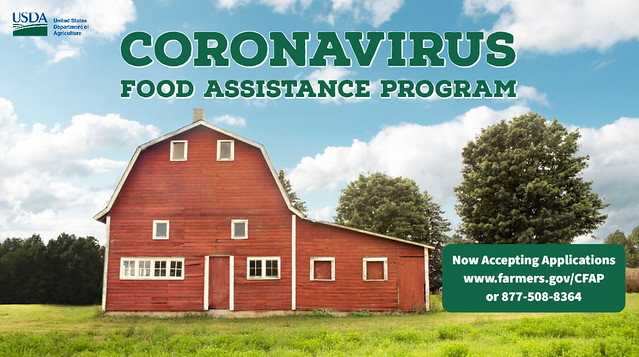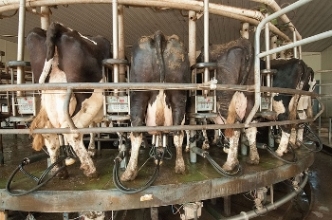USDA assistance is now available for producers who were hit by natural disasters in 2018 and 2019. Lord knows there were enough of them to last most farmers a lifetime.
The U.S. Department of Agriculture’s (USDA) Farm Service Agency (FSA) today announced that signup for the Quality Loss Adjustment (QLA) Program will begin Wednesday, Jan. 6, 2021. Funded by the Further Consolidated Appropriations Act of 2020, this new program provides assistance to producers who suffered eligible crop quality losses due to natural disasters occurring in 2018 and 2019. The deadline to apply for this USDA assistance is Friday, March 5, 2021.

“Farmers and livestock producers nationwide experienced crop quality losses due to natural disasters in 2018 and 2019,” said. Bill Northey, USDA Under Secretary for Farm Production and Conservation. “We have worked diligently over the past couple of years to roll out meaningful USDA assistance programs to help alleviate the substantial financial loss experienced by so many agricultural producers, and are pleased to offer quality loss assistance as added relief. Many of the eligible producers have already received compensation for quantity losses.”
Eligible Crops
Crops eligible for USDA assistance include those for which federal crop insurance or Noninsured Crop Disaster Assistance Program(NAP) coverage is available, except for grazed crops and value loss crops, such as honey, maple sap, aquaculture, floriculture, mushrooms, ginseng root, ornamental nursery, Christmas trees, and turfgrass sod.
Additionally, crops that were sold or fed to livestock or that are in storage may be eligible; however, crops that were destroyed before harvest are not eligible. Crop quality losses occurring after harvest, due to deterioration in storage, or that could have been mitigated, are also not eligible.
Qualifying Disaster Events
Losses must have been a result of a qualifying disaster event (hurricane, excessive moisture, flood, qualifying drought, tornado, typhoon, volcanic activity, snowstorm, or wildfire) or related condition that occurred in calendar years 2018 and/or 2019.
Assistance is available for eligible producers in counties that received a qualifying Presidential Emergency Disaster Declaration or Secretarial Disaster Designation because of one or more of the qualifying disaster events or related conditions.
Lists of counties with Presidential Emergency Disaster Declarations and Secretarial Disaster Designations for all qualifying disaster events for 2018 and 2019 are available here. For drought, producers are eligible for QLA if the loss occurred in an area within a county rated by the U.S. Drought Monitor as having a D3 (extreme drought) or higher intensity level during 2018 or 2019.
Producers in counties that did not receive a qualifying declaration or designation may still apply but must also provide supporting documentation to establish that the crop was directly affected by a qualifying disaster event.
To determine QLA eligibility and payments, FSA considers the total quality loss caused by all qualifying natural disasters in cases where a crop was impacted by multiple events.
Applying for QLA
When applying, producers are asked to provide verifiable documentation to support claims of quality loss or nutrient loss in the case of forage crops. For crops that have been sold, grading must have been completed within 30 days of harvest, and for forage crops, a laboratory analysis must have been completed within 30 days of harvest.
Some acceptable forms of documentation include sales receipts from buyers, settlement sheets, truck or warehouse scale tickets, written sales contracts, similar records that represent actual and specific quality loss information, and forage tests for nutritional values.
Payments Calculations and Limitations
QLA payments are based on formulas for the type of crop (forage or non-forage) and loss documentation submitted. Based on this documentation FSA is calculating payments based on the producer’s own individual loss or based on the county average loss. More information on payments can be found on farmers.gov/quality-loss.
FSA will issue payments once the application period ends. If the total amount of calculated QLA payments exceeds available program funding, payments will be prorated.
For each crop year, 2018, 2019 and 2020, the maximum amount that a person or legal entity may receive, directly or indirectly, is $125,000. Payments made to a joint operation (including a general partnership or joint venture) will not exceed $125,000, multiplied by the number of persons and legal entities that comprise the ownership of the joint operation. A person or legal entity is ineligible for QLA payment if the person’s or legal entity’s average Adjusted Gross Income exceeds $900,000, unless at least 75% is derived from farming, ranching or forestry-related activities.
Future Insurance Coverage Requirements
All producers receiving QLA Program payments are required to purchase crop insurance or NAP coverage for the next two available crop years at the 60% coverage level or higher. If eligible, QLA participants may meet the insurance purchase requirement by purchasing Whole-Farm Revenue Protection coverage offered through USDA’s Risk Management Agency.
More Information
For more information, visit farmers.gov/quality-loss, or contact your local USDA Service Center. Producers can also obtain one-on-one support with applications by calling 877-508-8364.
All USDA Service Centers are open for business, including those that restrict in-person visits or require appointments. All Service Center visitors wishing to conduct business with FSA, Natural Resources Conservation Service, or any other Service Center agency should call ahead and schedule an appointment. Service Centers that are open for appointments will pre-screen visitors based on health concerns or recent travel, and visitors must adhere to social distancing guidelines. Visitors are also required to wear a face covering during their appointment. Our program delivery staff will continue to work with our producers by phone, email and using online tools. More information can be found at farmers.gov/coronavirus.


